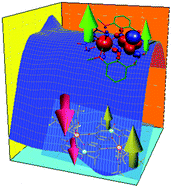Decisive interactions that determine ferro/antiferromagnetic coupling in {3d–4f} pairs: a case study on dinuclear {V(iv)–Gd(iii)} complexes†
Abstract
The emerging class of mixed transition metal and lanthanide {3d–4f} complexes have gained more interest in recent years in the field of molecular magnetism. The key to success in this class of compounds lies in the nature of their observed magnetic coupling, which is mostly ferromagnetic. However several exceptions have emerged in recent years which makes understanding the origin of magnetic coupling crucial. DFT and CASSCF calculations have been performed on a structurally similar pair of {V(IV)–Gd(III)} complexes to underpin the dilemma of ferro/antiferromagnetic exchange interaction. We have chosen two structurally similar complexes, [L1V(O)Gd(H2O)(NO3)3] (1); which displays a ferromagnetic interaction (J = +1.5 cm−1) between the {V(IV)–Gd(III)} pair, while complex [L2V(O){(CH3)2CO}Gd(NO3)3], (2) (see text for descriptions of L1 and L2) exhibits an antiferromagnetic exchange (J = −2.6 cm−1). The DFT calculations yield J values of +2.0 cm−1 and −0.7 cm−1 for complexes 1 and 2 respectively and these values are in good agreement with the experimental values. CASSCF calculations have also been performed to understand the nature of the interaction in these complexes. The MO and NBO analysis demonstrate the importance of Gd(III) vacant 5d orbitals which contribute to the ferromagnetic part of the J values in this class of complexes. The extensive magneto-structural correlations developed suggests that a combination of two parameters, the V–O–Gd angle and the V–O–Gd–O dihedral angle, control the sign as well the magnitude of the J values. We have extended our studies to a tetranuclear [L3V(O)Gd(hfac)2(CH3OH)2]2 complex to validate the proposed mechanism and the developed correlation. Our calculations also reveal that weak interactions are playing an important role in predicting the ground state for large polynuclear complexes.


 Please wait while we load your content...
Please wait while we load your content...